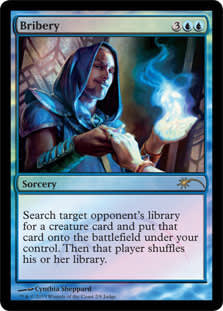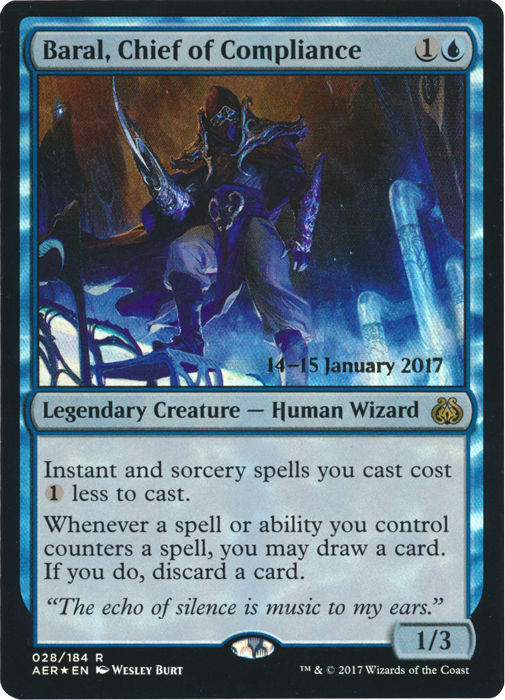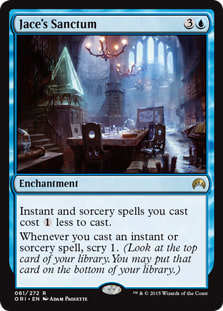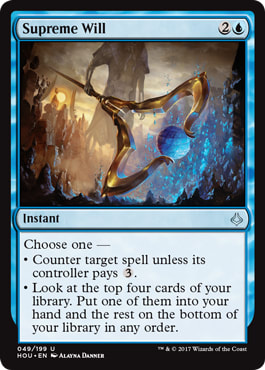This week for Cryptic Commander, I want to take a look at a Legendary Creature that gets kind of a bum rep as a ![]()
![]() commander option. Niv-Mizzet, the Firemind often steals the spotlight when it comes to Izzet (fitting given his position as the head of the Izzet League), but I’ve always had my eye on something a little more interesting. Sure, Niv is powerful, but power level had never been the deciding factor in how I build my decks. No. I want to build a deck around a Legendary Creature that was fridged before they had time to shine: A commander that presents some interesting deck-building challenges.
commander option. Niv-Mizzet, the Firemind often steals the spotlight when it comes to Izzet (fitting given his position as the head of the Izzet League), but I’ve always had my eye on something a little more interesting. Sure, Niv is powerful, but power level had never been the deciding factor in how I build my decks. No. I want to build a deck around a Legendary Creature that was fridged before they had time to shine: A commander that presents some interesting deck-building challenges.
Get ready for some High Voltage with this Electric Six-Drop!
Melek, Izzet Paragon is a 2/4 for ![]()
![]()
![]() . Not the most exciting stats, but it would be a strange day indeed that we played Melek to beat down in the red zone. Where I start to see the potential in this Weird Wizard is in the static abilities.
. Not the most exciting stats, but it would be a strange day indeed that we played Melek to beat down in the red zone. Where I start to see the potential in this Weird Wizard is in the static abilities.
You may cast the top card of your library if it’s an instant or sorcery card.
Whenever you cast an instant or sorcery from your library, copy it. You may choose new targets for the copy.
So, what directions do these abilities point us in?
- We want to be playing a large number of instants and sorceries in our deck to be sure we can cast cards from the top of our library as often as possible.
- Having ways to manipulate the top cards of our library is very important for giving us more control over hitting with Melek.
- Given a large concentration of instants and sorceries, playing some number of cards that care about instants and sorceries alongside Melek seems like a good plan.
Surface level, Melek wants us to play a lot of Instants/Sorceries so we can cast and copy them from the top of our library.
Easy enough. There’s a pretty substantial issue with that gameplan, though. How do we win? There are a couple of combo options out there, I’m sure. Generating infinite mana and then killing everyone with Fireball is definitely a direction you could take this deck in, but I’m not the biggest fan of infinite combos. They have their place as a way to ends games that have been dragging, but I never want them to be too easy to assemble or be the primary win condition for my decks. So, failing infinite combos as an option for a win con, we could always build Storm. Again, I’m not particularly interested in playing with something so combo-centric as Storm. I want my games to play out differently every time, and I have some ideas for a couple of ways to make that happen and still be victorious from time to time. Take a look at the list I came up with:
High Voltage | Commander | Robert Burrows
- Commander (1)
- 1 Melek, Izzet Paragon
- Creatures (10)
- 1 Archaeomancer
- 1 Baral, Chief of Compliance
- 1 Bloodwater Entity
- 1 Galvanoth
- 1 Goblin Electromancer
- 1 Hypersonic Dragon
- 1 Keranos, God of Storms
- 1 Snapcaster Mage
- 1 Solemn Simulacrum
- 1 Torrential Gearhulk
- Planeswalkers (1)
- 1 Chandra, the Firebrand
- Instants (23)
- 1 Aetherspouts
- 1 Anticipate
- 1 Brainstorm
- 1 Chaos Warp
- 1 Counterflux
- 1 Cryptic Command
- 1 Cyclonic Rift
- 1 Desertion
- 1 Dig Through Time
- 1 Fact or Fiction
- 1 Impulse
- 1 Insidious Will
- 1 Misdirection
- 1 Mystic Confluence
- 1 Mystical Tutor
- 1 Opportunity
- 1 Prophetic Bolt
- 1 Refuse // Cooperate
- 1 Starstorm
- 1 Supplant Form
- 1 Supreme Will
- 1 Swan Song
- 1 Wild Ricochet
- Sorceries (13)
- 1 Blasphemous Act
- 1 Blatant Thievery
- 1 Bonfire of the Damned
- 1 Bribery
- 1 Epic Experiment
- 1 Mizzix's Mastery
- 1 Past in Flames
- 1 Ponder
- 1 Rite of Replication
- 1 Saheeli's Artistry
- 1 Spelltwine
- 1 Vandalblast
- 1 Volcanic Vision
- Enchantments (4)
- 1 Jace's Sanctum
- 1 Metallurgic Summonings
- 1 Soothsaying
- 1 Swarm Intelligence
- Artifacts (11)
- 1 Coalition Relic
- 1 Commander's Sphere
- 1 Darksteel Ingot
- 1 Gilded Lotus
- 1 Izzet Signet
- 1 Mind Stone
- 1 Scroll Rack
- 1 Sensei's Divining Top
- 1 Sol Ring
- 1 Sphinx-Bone Wand
- 1 Wayfarer's Bauble
- Lands (37)
- 13 Island
- 8 Mountain
- 1 Command Tower
- 1 Desolate Lighthouse
- 1 Forgotten Cave
- 1 Halimar Depths
- 1 Izzet Boilerworks
- 1 Izzet Guildgate
- 1 Lonely Sandbar
- 1 Myriad Landscape
- 1 Mystifying Maze
- 1 Reliquary Tower
- 1 Shivan Reef
- 1 Steam Vents
- 1 Sulfur Falls
- 1 Swiftwater Cliffs
- 1 Temple of Epiphany
- 1 Wandering Fumarole
Let’s cover my win conditions of choice first, since they dictate much of how I build the rest of the deck.
Winner Winner
There are two big categories of win cons I went with for the deck: using my own spells to kill my opponents and using my opponents’ spells to kill my opponents. The first category is more firmly under our control than the second, so we’ll break that down first. Sphinx-Bone Wand has to be my favorite way to win the game in this deck. It’s fragile, being a seven-mana do-nothing artifact, but it can kill people very quickly if they stop paying attention to it or you can protect it long enough to build up the counters. Every instant or sorcery you cast (it doesn’t have to resolve) places another counter on the wand and deals damage to target creature or player equal to the number of counters on the wand. Once you hit about five or six counters, things start getting out of hand pretty quickly!
Metallurgic Summonings plays a similar role to Sphinx-Bone Wand. Playing instants and sorceries with this in play will start building up a sizable force of blockers and attackers. Once again, the spells don’t even have to resolve for you to get the tokens from Metallurgic Summonings. This enchantment also has the benefit of acting as a mass Archaeomancer, returning every instant and sorcery in your graveyard to your hand to play again at the cost of losing your token generator. It’s a trade-off, but you should have a large enough force by that point to put your opponents away. Summonings is also a great source of resilient threats since wraths will leave the enchantment intact, allowing you to raise another army after the board is clear.
The second path to victory in this deck is to use your opponents’ cards against them. Bribery, Rite of Replication, Supplant Form, Saheeli's Artistry, and Blatant Thievery will let you use your opponents’ creatures and permanents against them while Insidious Will, Misdirection, Refuse // Cooperate, Wild Ricochet, and Spelltwine will let you turn their big spells to your purposes. This path is more dependent on what your opponents are playing (a very 75% approach in honor of fellow GM author Jason Alt), so keep your eyes open for opportunities to leverage these cards in the best way possible.
The Breakdown
With the win cons laid out, what should we fill the rest of the deck with? I’m gonna break it down categorically.
Library Manipulation:
Manipulating the top card of our library is essential in this deck. Luckily, there is no shortage of consistent and repeatable ways to do so.
I’m not the biggest fan of running Sensei's Divining Top in just any deck, but it is essential for Melek’s gameplan. Being able to swap the top three cards of our deck at any time is great for keeping a clutch instant a secret long enough to blow someone out. Soothsaying pulls double duty as a second Top and a way to shuffle away things that we don’t want to draw. Scroll Rack is a perfect way to get things from our hand on top of our library to double cast with Melek, or it can be used to save important cards on top of our deck from being milled or otherwise removed. Brainstorm is a classic, letting us put something on top for one mana at instant speed. Ponder also lets you rearrange the top three, or shuffle away stuff you’d rather not draw for now.
Discount City:
Making our instants and sorceries cheaper is always a good thing, and this triumvirate of discounts do just that.
Jace's Sanctum reduces the cost while also letting you scry whenever you cast an instant or sorcery. Baral, Chief of Compliance lets us loot whenever we counter a spell, which will happen occasionally in this deck. And then there’s Goblin Electromancer who is just happy to be here.
Spell Utility:
Giving our spells a little more flexibility and increasing our odds of doubling the value of any given spell is a tempting prospect. Luckily, Melek has some back up.
Having some other options for copying our spells is a great. Swarm Intelligence and Chandra, the Firebrand both deliver on that front. Galvanoth lets us cast spells from the top of our library for free on our upkeep. Hypersonic Dragon lets us cast sorceries at instant speed. Snapcaster Mage and Torrential Gearhulk are powerful as always, letting us cast spells from the graveyard, while Archaeomancer and Bloodwater Entity put the spells back into our hand, or on top of our library in the Entity’s case (which is such a big deal when Melek is in play).
Counterspells, Card Advantage, and Wraths:
I know how many Commander players feel about counterspells. Those players will be happy to know that many of my counterspell choices do things besides countering spells. Having your counters do more things makes them much more palatable when you see them staring back from the top of your deck. Nothing feels worse than having a Counterspell on top of your deck that everyone knows about.
The rest of the instants and sorceries in the deck all fall into these three categories. Most of the counterspells in the deck pull double or triple duty as card advantage or other forms of utility. Mystic Confluence, Supreme Will, Cryptic Command, and Insidious Will are my modal counterspells of choice with a few straight counters thrown in for good measure (Counterflux and Swan Song while Desertion lets us steal a threat). Fact or Fiction, Dig Through Time, Prophetic Bolt, Impulse, Opportunity, and Anticipate serve as our draw and dig. The early game for Melek is often spinning your wheels, casting card draw spells to find interaction or Metallurgic Summonings so you can start working toward winning the game. Cheap spells like Anticipate and Supreme Will that let you dig at instant speed so you can leave up counters or other juicy instants are the grease the makes the wheels spin effectively. Blasphemous Act, Starstorm, Bonfire of the Damned, Volcanic Vision, Aetherspouts, and Cyclonic Rift will clear the board for us to not die while we search for win cons. Turns out you can’t win the game if you die.
Wrapping Up
And that covers the major talking points of the deck. The mana rocks and ramp are up to your discretion, I just use the ones I like. The mana base is pretty standard, with a Halimar Depths and cycling lands as stand out interesting inclusions alongside Mystifying Maze. Having a land that lets you manipulate the top of your deck when it enters the battlefield is a nice bonus, and being able to interact with big threats coming in your direction is something I value highly, especially in a land slot.
So there you have it! I’ve played with the deck several times and it’s performed admirably. I’ve won with Sphinx-Bone Wand, Metallurgic Summonings, and making multiple copies of a Stormtide Leviathan, the original kindly being donated by one of my opponents. The deck has teeth and will definitely light a few fires in the disco, and under your opponents when they least expect it. As I play with the deck more, I’ve been considering throwing a few more ways to just kill opponents. What do you think? What spells would you add to the deck? How would you give it a more proactive gameplan? Let me know in the comments, and I’ll see you next time!










































